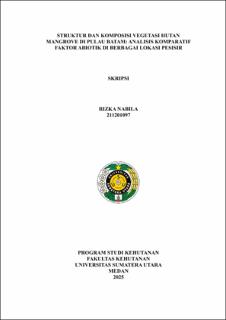| dc.description.abstract | Mangrove forests are crusial coastal ecosystems that provide essential ecological services, including shoreline protection, carbon sequestration, and support for marine habitat. Batam Island in the Riau Island Province hosts diverse mangrove vegetation, yet comprehensive studies on its structure, composition, and influencing abiotic factors are still limited. This study aims to analyze the structure and composition of mangrove vegetation across several coastal sites in Batam and examine abiotic factors such as salinity, temperature, and substrate type that may influence variations in vegetation, and also analyze mangrove vegetation biomass at the research location. Data were collected using transect based sample plots measuring 20 m × 20 m for trees, 10 m × 10 m for saplings, and 5 m × 5 m for seedlings. Biomass was estimated using allometric equations for each sapling and tree species found. Across four study sites, 10 mangrove species were recorded, with Rhizophora apiculata being present at all growth stages. The anthropogenic threats that are presumed to contribute most significantly in Teluk Lengung and Tangga Seribu are water pollution caused by waste disposal, whereas in Nongsa and Tiangwangkang the primary threat is land conversion into settlements. Salinity ranged from 2.94 % to 3.39 %, temperatures ranged from 24.3 °C to 27 °C, and substrates were mainly muddy with mixed particles. This study indicates that variations in several biotic factors influence the structure and composition of mangrove vegetation. Nongsa, characterized by clay- and organic-rich substrates, with a temperature range of 24.3 °C and a salinity of 3.39%, tends to support higher species diversity and a more complex vegetation structure compared to the other sites. | en_US |


